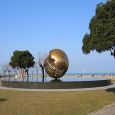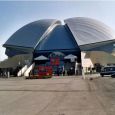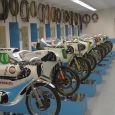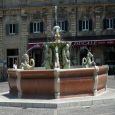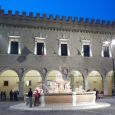Pesaro
Advertisement
By Air
The nearest international airports to the city of Pesaro are as follows Rimini-Miramare airport 20 km.Ancona-Falconara Airport 65 km.Forli Airport 85 km and Bologna Airport-Ducati 140 km.
By Train
Pesaro is crossed by the railway line Bologna-Ancona and has a train station, located near the historic center.From the point of view of the carriage of passengers the station of Pesaro is served from sixty to one hundred twenty trains a day.The property is included in the project Centostazioni, providing for the expansion and upgrading by 2015.
By Road
Pesaro is crossed by A14, accessible from exit Pesaro-Urbino is in the process of building the third lane, which will also lead to the construction of a new exit Pesaro center.The city is crossed by the highway SS16 Adriatica.It is in the design phase Montelabbatese the new road that will link the city with Urbino, strengthening the existing road network.It was only recently completed the 3 rd batch dell interquartieri, the city bypass, which connects quickly with the district Baratoff Torraccia.The project should provide an additional lot which will link with the hospital of Wall, where there is a section in the gallery.The realization of this project will be crucial for the construction of new Montelabbatese.
By Bicycle
On the waterfront of Pesaro is already in operation on the common trait Ciclovia Adriatic, the long bike path to the Adriatic coast, in the forward link the mouth of the Po with the Apulia. The territory is currently covered by about 60 km of these tracks.
Morbidelli Museum
is located in Pesaro Italy, very near the start place of this years Motogiro d Italia.This is the second year we have visited what many people consider to be one of the most important collections of motorcycles in the world. It's the result of 25 years of research and collecting - 3000 sq meters, 400 motorcycles ranging from 1900 to 1980.Giancarlo Morbidelli, creator of the museum and father of Gianni Morbidelli F1 racing driver, has been passionate for motorcycles since childhood. With his engineering company as sponsor he built his own racing motorcycles and won 4 world titles in the 70s.He might be best known for producing his own motorcycle.A V8 850cc motorcycle, you may have seen one on display in the Art of the Motorcycle or at the Barber Museum in the USA.He's a staple in the Italian motorcycling industry, considered a mechanical genius and immensly respected worldwide.The museum maintains limited hours, this visit was by pre-arrangement on a Sunday at a time they are normally closed.As in the past we felt lucky to be able to visit this shrine to this amazing man's life work.
Civic Museums
Is located in Piazzale Toschi-Mosca 29 and include the Art Gallery and the Museum of Ceramics.Museums are famous mainly for the awesome Pesaro Altarpiece of Giovanni Bellini, one of the key works of the development of the Venetian Renaissance.At the same author reported on a head of John the Baptist and an Eternal Father.The gallery displays works from the area, the collection contains Rossini, with teachers Marche, Veneto, Tuscany and Emilia, including Vitale da Bologna, Tintoretto, Ludovico Carracci, Guido Reni.Some rooms are also dedicated to the collections of pottery, distinguished by the majolica sixteenth of local production, especially of Urbino, Pesaro, Casteldurante and Urbania.There are also pieces on display, ranging from the rococo MIDDLE AGES, including Hispanic-Moorish origin, and English.In the entrance courtyard is the Medusa, by the late Art Nouveau ceramics Ferruccio Mengaroni.
Ducal Palace
is a palace renaissance of Pesaro, today seat of the prefecture.It is located in Piazza del Popolo, and was built by Alessandro Sforza in the mid- fifteenth century, on a core that was originally the property of Malatesta.The facade consists of an arcade of six arches held up by massive pillars and to draft an upper floor with five windows crowned by coats of arms, garlands and putti.The right side (the only side visible), has the bow end of the arcade-style Gothic and, upstairs, two large windows, similar to the front but no crown.Inside the building the fireplace in the waiting room was designed by Frederick Brandani and depicts a chariot race around the walls Rovere, the other halls are decorated with arabesques and the dressing room, bathroom and is decorated with stucco polychrome.
Villa Imperiale
is an old manor house outside the town, located on the San Bartolo hill near the city. Monument of the Renaissance, was built in two phases of construction between the XV and XVI century.The first building was begun shortly after the mid-fifteenth century at the behest of Alexander Sforza . Despite having the character of a place of delight out of the city, still had formal characteristics of defensive architecture, as a crowning battlements (later removed) and turrets, as was customary at the time. The name derives from the fact that the Emperor Frederick III of passage in Pesaro in 1469, had stayed in the new built villa.In the second decade of the sixteenth century, the Duke Francesco Maria I della Rovere and his wife Eleonora Gonzaga, who had regained the duchy of Urbino after a long exile in Cesena and Mantua, commissioned Girolamo Genga to renew and expand the existing building, having decided to hold the court in Pesaro.
Cathedral of Santa Maria Assunta
is the cathedral of Pesaro and the cathedral of Archdiocese of the same name.The current building has ancient origins.The presence of two floors decorated with mosaics, one above the other, proving the existence of two early Christian churches: the first dating from the fourth century, the second to the second half of the sixth century, after the first was destroyed during the Gothic wars of the 535 - 553.The church became a cathedral, or bishop's seat, in the seventh century, when the relics were transferred to the patron saint of Pesaro, San Terenzio, who was initially dedicated to the cathedral.The church was enriched with gifts by Malatesta and the Sforza.It was later rebuilt completely style the Baroque, with the consequent destruction of the apse of the church tower, the baptistery and atrium porch, and dedicated to the Assumption in 1663.Finally in the late nineteenth century and early twentieth the building's interior was reformulated style neoclassical by Giovanni Battista Carducci and Luigi Galli, assuming the present appearance.
Rossini's House
is the name of the museum dedicated to the great composer Gioachino Rossini.It is located in Pesaro, in the building where the artist was born in 1792, in Rossini No 34.Inside the museum you can enjoy a fair amount of material, the result of several donations.With DR No 95 of 25 February 1904 has been declared a national monument.The exterior of the building has no special artistic qualities, especially compared to neighboring patrician residences of the city. However, its particular structure stands along the way and is appreciated by Pesaro.Rossini's house was built between the fifteenth and the eighteenth century, with subsequent interventions.The building has four floors and a basement.Inside the building, visitors follow a particular route-creative biography, is a different documentary material, including prints and memorabilia related to the life and work of composer.The core of the collection is the gift of the great collector in Paris Hubert Alphonse Martel.
Information not available


